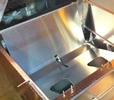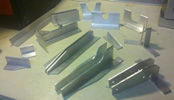


random user submitted photo
Red Riter pencils for aluminum marking
4 posts
• Page 1 of 1
Red Riter pencils for aluminum marking
Sharpie's work for some marking tasks, but i am interested in finding something more precise... I've heard that the carbon/graphite of a normal pencil is unsuitable and promotes corrosion...
I've been looking at red riter / silver streak pencils... They seem to be a true lead-based pencil... Does anyone have experience with them, know if its safe to use as a marking tool?
I've been looking at red riter / silver streak pencils... They seem to be a true lead-based pencil... Does anyone have experience with them, know if its safe to use as a marking tool?
- dxlusby84
- Posts: 19
- Joined: Sun Nov 13, 2016 1:13 am
Re: Red Riter pencils for aluminum marking
Ultra fine tipped Sharpies make a line as narrow and precise as any pencil - no need for exotic solutions or materials. :-)
Here are some options on Amazon.com
Enjoy!
—Noel
Sonex #1339
Here are some options on Amazon.com
Enjoy!
—Noel
Sonex #1339
- NWade
- Posts: 527
- Joined: Mon Aug 08, 2011 3:58 pm
Re: Red Riter pencils for aluminum marking
dxlusby84 wrote:Sharpie's work for some marking tasks, but i am interested in finding something more precise... I've heard that the carbon/graphite of a normal pencil is unsuitable and promotes corrosion...
I've been looking at red riter / silver streak pencils... They seem to be a true lead-based pencil... Does anyone have experience with them, know if its safe to use as a marking tool?
So I had always heard of the pencil/AlClad corrosion issue. I think one of Mike Busch's webinars covered how when it got wet it set a a small cell and galvanic corrosion occurred. Still - nothing like doing a little digging. Lots of sources agree on this. But this is one of the better explanations of "real world" that I could find. By this explanation - your proposed use of a "real lead" pencil would cause the same problem. While not a builder - I do metalwork on the plane for brackets and the like.
I either use a fine Sharpie and - as my old shop teacher used to say when teaching me to saw a bit of wood: "saw to the side - just 'skliffing' the line - then plane to dimension". So for AlClad - saw to the side of the Sharpie line then file to dimension and smooth the cut to avoid stress risers.
OR
If I DO scribe with a sharp point - it is with the intention to file smooth to eliminate the scribe line.
Another post found online wrote:The American Boat and Yacht Council (ABYC) series lists graphite as the most
passive (cathodic) material. Aluminum alloys are 4th from the most active
(anodic).
The series from the Corrosion Engineering Handbook at work lists graphite in 3rd
place next to gold and platinum as the most passive, and aluminum alloys in 5th
place as the most active.
So, when we put the pencil line on the aluminum we have put two of the most
incompatible materials in the series together!
If we accept that putting these two materials together constitutes a galvanic
cell, we can also imagine that the subsequent galvanic corrosion will result in
a small fault line, just like the scribe mark and lead to the same accelerated
failure.
Putting some paint over the thing doesn't do a heck of a lot to slow it down.
Water migrates thru most paints. This doesn't cause many problems when the parts
are left in open air to breathe. Wrap them up and let them sit for long periods
of time and the paint will blister.
We just had that happen to a dozen spars shipped to England last August. They
got wet along the way and sat till November. All of them had blisters due to
moisture trapped in the coatings. This was really expensive high grade polyurethane
paint, similar to that used on aircraft.
I think that in the case of the gentleman that posted the comments about seeing
the problem on aircraft, the ability of the moisture to migrate through the
coating and be held in place probably exacerbated the problem. Probably would
have been better to have it all bare in the open to allow someone to see the
problem before it failed.
At my real job, we manufacture carbon fiber/epoxy spars for the marine industry.
The chemical composition of the actual carbon (or graphite) fibers are very
nearly identical to the the stuff in pencil lead. The big difference is that the
carbon filaments have a more highly oriented molecular structure to exhibit
better physical properties, but carbon is still carbon on the galvanic series.
Every time we put a piece of aluminum in contact with the carbon we get a
frothing mess in less than 6 months on the sea. The aluminum is more active so,
it always loses the battle. The aluminum just dissolves and the carbon composite
remains just fine.
Graeme JW Smith
-

GraemeSmith - Posts: 939
- Joined: Sat May 18, 2019 8:58 am
- Location: RI
Re: Red Riter pencils for aluminum marking
NWade wrote:Ultra fine tipped Sharpies make a line as narrow and precise as any pencil - no need for exotic solutions or materials. :-)
Here are some options on Amazon.com
Enjoy!
—Noel
Sonex #1339
Part of why I want to move to the "pencil" format is because I use some marking rules (like this https://www.incra.com/measuring_marking-rule_sets.html). Even the ultra fine tips have a real hard time fitting into the marking holes. It's definitely a quality of life desire, not a minimum requirement - can always slide a combination square up to an edge and mark along the ruler edge... Would be nice, though :)
- dxlusby84
- Posts: 19
- Joined: Sun Nov 13, 2016 1:13 am
4 posts
• Page 1 of 1
Who is online
Users browsing this forum: No registered users and 24 guests







